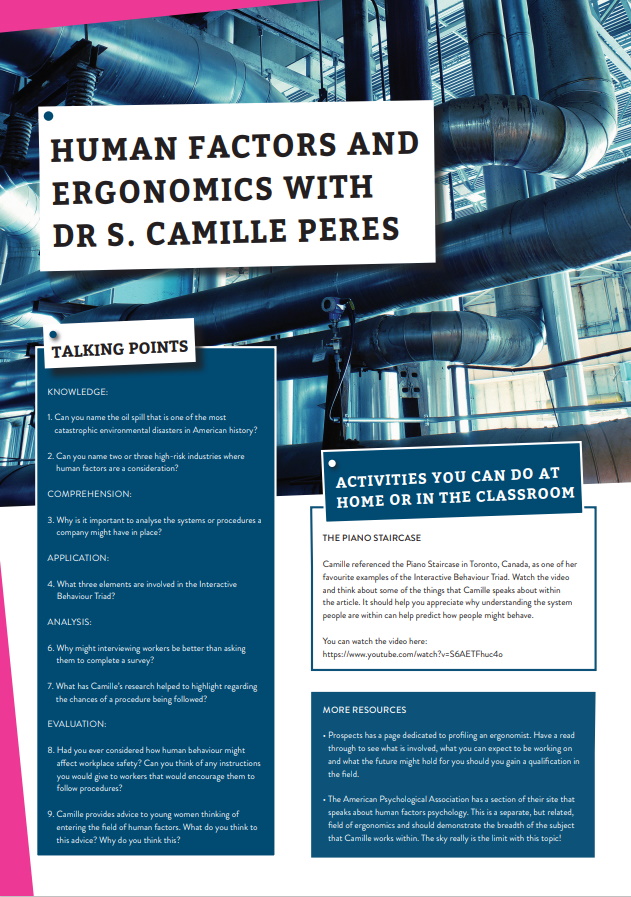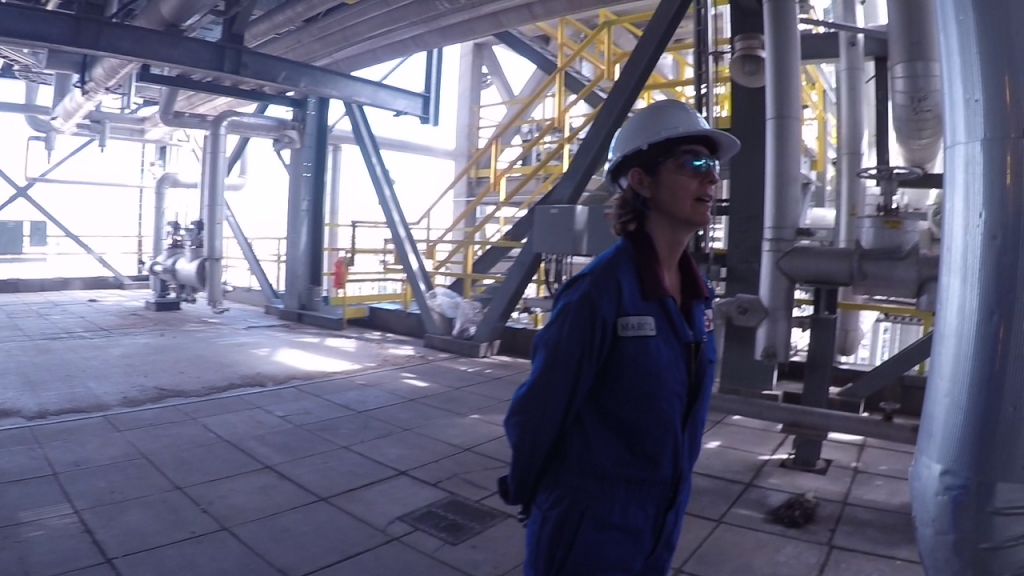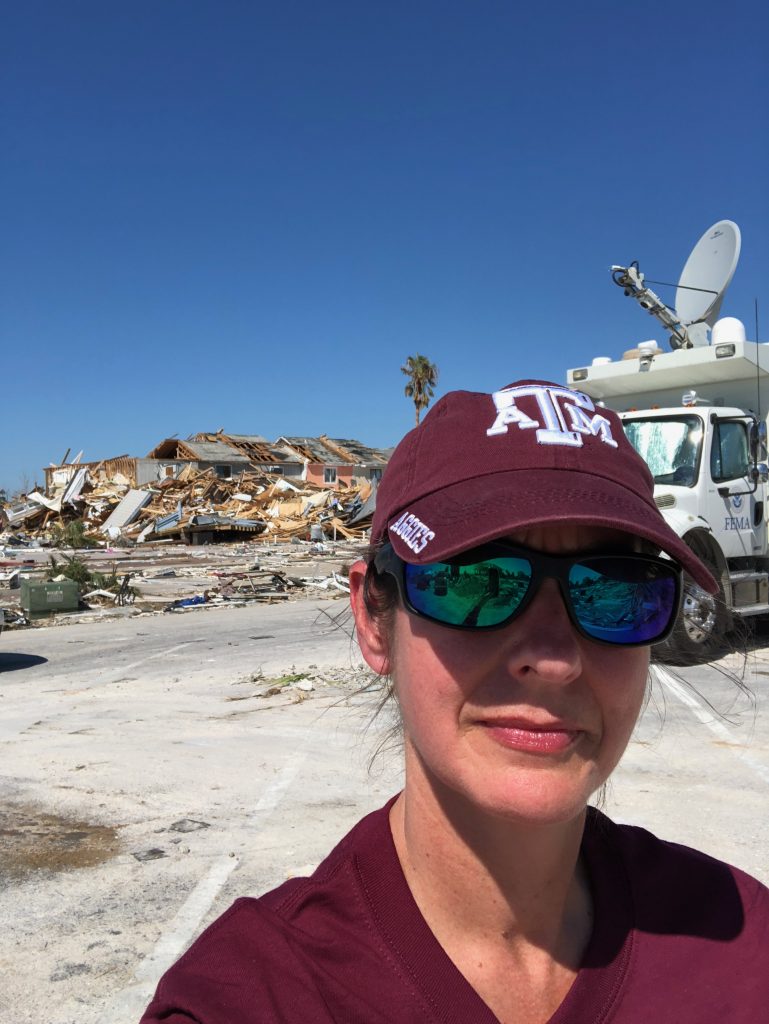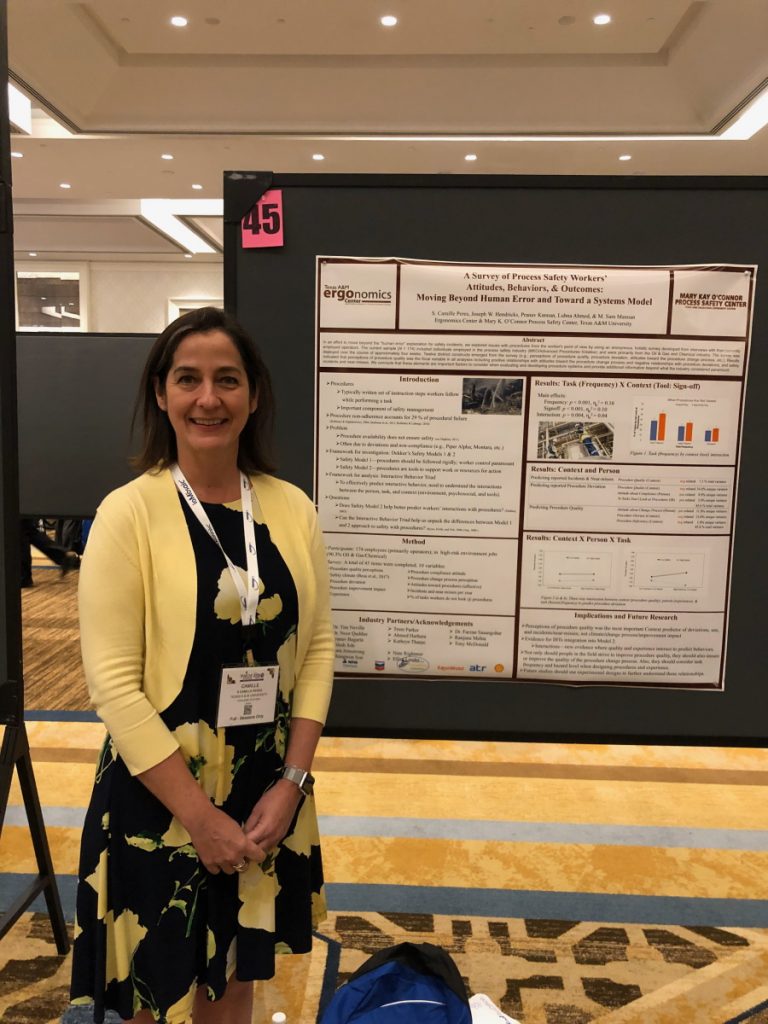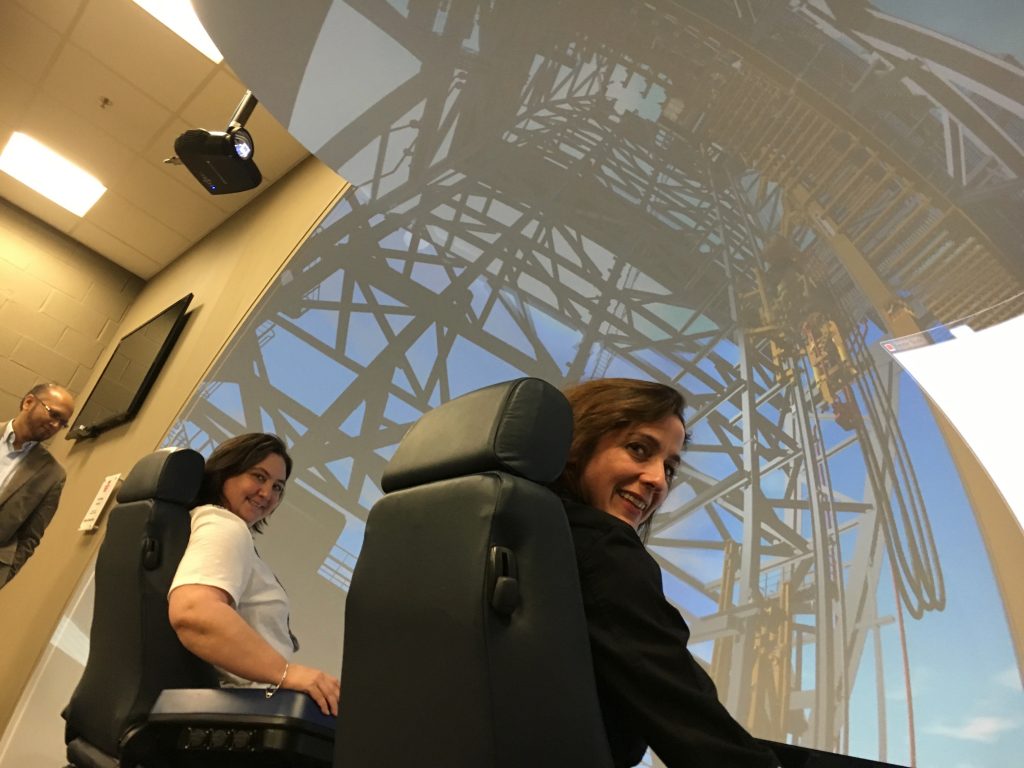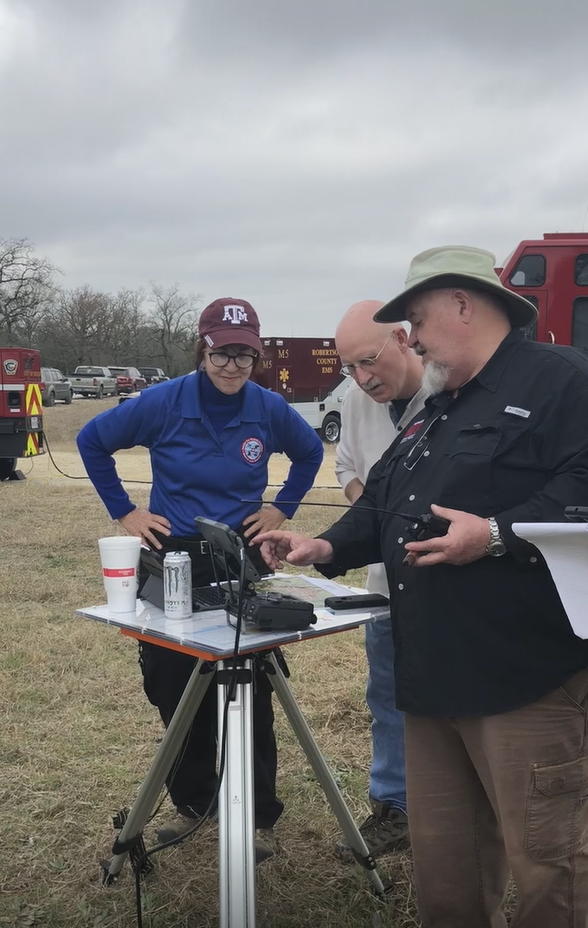Human factors in the gas and oil industries
Dr S. Camille Peres is based at Texas A&M University in the US. What shines through most of all is her love and fascination for her work – which is centred on understanding how human behaviour can lead to incidents in high-risk industries
The Deepwater Horizon oil spill was an industrial disaster that occurred just over a decade ago. It is thought to be the biggest marine oil spill in history and one of the most catastrophic environmental disasters that has ever happened in American history. In the aftermath of the disaster, researchers from a range of scientific disciplines and across industries worked to understand the reasons for the accident, in the hope that something like this would never happen again.
The petrochemical, oil and gas industries have long been known as high-risk, not least because of the potential volatility of the materials involved and the complexity of the work involved. Human factors can also play a significant role and Dr S. Camille Peres, based at Texas A&M University in the USA, is working on understanding those factors. One of the main focuses of Camille’s research is how human behaviour can lead to incidents such as the Deepwater Horizon oil spill and she has produced a report that finds a link between procedural issues and these incidents.
WHAT ARE THESE PROCEDURAL-RELATED ISSUES AND HOW COMMON ARE THEY?
The damage caused by the Deepwater Horizon oil spill is almost unimaginable and Camille has found that procedural issues are a significant cause of such incidents. “Some of the interesting things we are finding are that the issues workers tell us about are very different to the issues their bosses think they are experiencing,” explains Camille. “For instance, workers tell us it’s very hard to correct incorrect procedures in a timely manner.” It is clear those with the knowledge that something is wrong cannot significantly influence making it right, at least not quickly. In addition, Camille has found that more experienced workers tend to ignore some of the procedures and may be more likely to make a careless mistake.
WHAT IS THE INTERACTIVE BEHAVIOUR TRIAD?
The Interactive Behaviour Triad is a way of looking at the entire system where people are doing tasks or work so Camille and her team can better understand and predict how people might behave. “As the name suggests, the Triad consists of three elements: the person, the task and the context,” says Camille. “We can use the information about these three aspects to predict which tool or method a person will use, depending on their specific circumstance.”
One of Camille’s favourite examples of this is a piano staircase in Toronto, Canada. Within the Triad, the task is to get from one floor to other (either up or down). There are some hazards because people could fall, but the chances of that are low. The people involved are of various ages, some may be in a rush, while others may be elderly and go slower. The context is that it could be the end of the day, when people are tired, but it could also be the start of the day when people are running late. Importantly, there are two distinct ‘tools’ to accomplish the task of getting from one floor to the other – the escalator or the piano stairs (which make a noise when anyone steps on them).
The predictions that come from this particular Interactive Behaviour Triad might be three-fold:
- If someone is feeble and less confident in his/her ability to go up and down stairs, that person will probably take the escalator to reduce the risk of falling on the stairs (even though he or she may have wanted to go on the piano stairs).
- If someone is physically able, but has a headache, they might go on the escalator to avoid the noise (and possibly frown at those who use the piano stairs).
- If someone is physically able and on his/her way to work, even if he or she doesn’t normally take the stairs, this person might decide to in this instance because these stairs make them smile.
From this, we can see how by analysing the systems or procedures in place, it is possible to predict which option an individual will take. This can be extracted and applied to industry procedures, to maximise the chances that safety guidelines will be followed.
WHY DID CAMILLE CHOOSE TO CONDUCT INTERVIEWS WITH THE WORKERS?
Put simply, it is easier to obtain richer information from conducting interviews. If you ask people to complete a survey or participate in an experiment, there is a two-dimensional aspect to the information. That’s not to say it isn’t useful, but interviewing people can help the team discover information they might not have even considered. “In one interview, a very experienced worker told us that because he has a lot of experience, people ask him a lot of questions – which is a good thing!” says Camille. “However, it also means he gets interrupted a lot and we know from research that interruptions can cause people to make mistakes.”
WHAT HAVE BEEN THE KEY FINDINGS AND RECOMMENDATIONS FROM CAMILLE’S STUDY?
Camille’s research highlights how a worker’s experience and the frequency of the tasks they are asked to perform influences the chances of a procedure being followed. After performing the same task multiple times, a worker will often start acting on instinct and ‘tune out’. It is difficult to overcome this problem; often, a person’s instincts make them a very good worker, so a balance needs to be found.
The main recommendation from the study is that companies need to start using digital procedures so they can be presented differently depending on the situation. “One example concerns less experienced workers, who are likely to need more information than their more experienced colleagues,” says Camille. “We are currently writing grants to develop procedures that will automatically adapt to the work and the worker’s situation.”
Ultimately, having procedures in place is essential to ensure the safety of the workers and minimise the chances of incidents. Camille’s research acknowledges this but also focuses on what needs to happen to encourage people to follow procedures. The best chance of achieving this is to understand what affects whether a person follows a procedure and then to accommodate those reasons in the way procedures are written and presented.
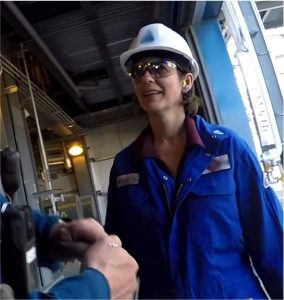 DR S. CAMILLE PERES
DR S. CAMILLE PERES
Public Health, Texas A&M University, USA
FIELD OF RESEARCH: Human Factors and Ergonomics
RESEARCH PROJECT: Camille’s research is focused on understanding how issues related to procedure are linked to incidents in high-risk industries, such as petrochemical, oil and gas.
FUNDER: National Science Foundation, National
Institute of Health, Next Generation
Advanced Procedures Consortium, Texas
A&M University School of Public Health
ABOUT HUMAN FACTORS
Sometimes referred to as an ergonomist, Camille is an expert in human factors. The focus of her studies is on the safety and efficiency of systems and procedures, which also involves understanding human behaviour. As such, her work encompasses a wide range of different fields of enquiry, including psychology, technology and design. Having spoken with Camille, one thing that stands out above anything else is her passion and deep love for her work.
WHAT DOES CAMILLE FIND MOST REWARDING ABOUT HER WORK?
“I have always loved three things in particular about my work,” explains Camille. “Helping people, playing with technology and conducting research. In the field of human factors, I get to combine all three things and it is so much fun!”
WHAT ADVICE WOULD CAMILLE OFFER YOUNG WOMEN ENTERING THE FIELD?
Much of Camille’s research has been conducted in typically male-oriented industries. One example of this is that the studies detailed above involved interviews with male personnel only. So, it was interesting to speak with Camille about whether she has any advice to give to young women thinking about embarking on a career in human factors. “Surround yourself with positive, strong female advocates. Even if they’re not in your field of study, having them around you regularly will give you examples of what it looks like to be a strong, positive woman,” says Camille. “Know that when someone questions whether you’re capable because you’re a woman, it’s THEIR issue, not yours. Shoulders back, chin up and charge forward!” We could not agree more.
WHAT IS THE MOST PRESSING ISSUE IN THE CURRENT STUDIES OF HUMAN FACTORS AND WHERE WILL CAMILLE’S RESEARCH GO IN THE FUTURE?
The most pressing thing is probably the constant adjustment to new technology in the workplace. This can make it challenging to determine how to be safe and effective with new technology, as this is not always considered in the development of it. As for her own research, Camille says she sees herself continuing to explore how to better integrate attributes of humans into the complex systems of refineries, chemical plants, oil rigs, etc.
HOW TO BECOME INVOLVED IN HUMAN FACTORS
• Camille says those who are interested in working in human factors should apply to a university that has a dedicated human factors programme. There is a list on the Human Factors and Ergonomics Society website: www.hfes.org/
• There is also a tremendous number of resources on the HFES site dedicated to those preparing for a career in human factors and ergonomics:
www.hfes.org/publications/freepublications/preparing-for-a-career-inhuman-factorsergonomics-a-resource-guide
• According to Prospects, entry level ergonomists in the UK can earn between £19,000 to £27,000. With experience, this salary rises to between £35,000 to £65,000. www.prospects.ac.uk/jobprofiles/ergonomist
• According to Salary.com, the average salary for an ergonomist in America is $75,000. Camille explains that salaries can depend on whether you have a BA or MA, as well as experience. www.salary.com/research/salary/posting/ergonomist-salary
Reference
https://doi.org/10.33424/FUTURUM97
From http://thefuntheory.com – A piano staircase in Toronto, Canada, where people can choose how they get from one floor to another.
Camille, learning about how chemicals are used to make plastics. record their work.
As part of the response to Hurricane Michael, Camille was a participant researcher embedded in a team of unmanned aerial vehicle pilots.
Camille spent a night on board the naval aircraft carrier USS Lincoln to learn how it operates.
Camille presenting some of her findings at an international research conference.
Camille and her doctoral student, W. Sloane Hoyle, in a drilling simulator.
Dr Robin Murphy with the CRASAR team participating in a simulation exercise of a search and rescue mission. Camille conducted research with CRASAR.
The petrochemical, oil and gas industries have long been known as high-risk, not least because of the potential volatility of the materials involved and the complexity of the work involved. Human factors can also play a significant role and Dr S. Camille Peres, based at Texas A&M University in the USA, is working on understanding those factors. One of the main focuses of Camille’s research is how human behaviour can lead to incidents such as the Deepwater Horizon oil spill and she has produced a report that finds a link between procedural issues and these incidents.
WHAT ARE THESE PROCEDURAL-RELATED ISSUES AND HOW COMMON ARE THEY?
The damage caused by the Deepwater Horizon oil spill is almost unimaginable and Camille has found that procedural issues are a significant cause of such incidents. “Some of the interesting things we are finding are that the issues workers tell us about are very different to the issues their bosses think they are experiencing,” explains Camille. “For instance, workers tell us it’s very hard to correct incorrect procedures in a timely manner.” It is clear those with the knowledge that something is wrong cannot significantly influence making it right, at least not quickly. In addition, Camille has found that more experienced workers tend to ignore some of the procedures and may be more likely to make a careless mistake.
WHAT IS THE INTERACTIVE BEHAVIOUR TRIAD?
The Interactive Behaviour Triad is a way of looking at the entire system where people are doing tasks or work so Camille and her team can better understand and predict how people might behave. “As the name suggests, the Triad consists of three elements: the person, the task and the context,” says Camille. “We can use the information about these three aspects to predict which tool or method a person will use, depending on their specific circumstance.”
One of Camille’s favourite examples of this is a piano staircase in Toronto, Canada. Within the Triad, the task is to get from one floor to other (either up or down). There are some hazards because people could fall, but the chances of that are low. The people involved are of various ages, some may be in a rush, while others may be elderly and go slower. The context is that it could be the end of the day, when people are tired, but it could also be the start of the day when people are running late. Importantly, there are two distinct ‘tools’ to accomplish the task of getting from one floor to the other – the escalator or the piano stairs (which make a noise when anyone steps on them).
The predictions that come from this particular Interactive Behaviour Triad might be three-fold:
- If someone is feeble and less confident in his/her ability to go up and down stairs, that person will probably take the escalator to reduce the risk of falling on the stairs (even though he or she may have wanted to go on the piano stairs).
- If someone is physically able, but has a headache, they might go on the escalator to avoid the noise (and possibly frown at those who use the piano stairs).
- If someone is physically able and on his/her way to work, even if he or she doesn’t normally take the stairs, this person might decide to in this instance because these stairs make them smile.
From this, we can see how by analysing the systems or procedures in place, it is possible to predict which option an individual will take. This can be extracted and applied to industry procedures, to maximise the chances that safety guidelines will be followed.
WHY DID CAMILLE CHOOSE TO CONDUCT INTERVIEWS WITH THE WORKERS?
Put simply, it is easier to obtain richer information from conducting interviews. If you ask people to complete a survey or participate in an experiment, there is a two-dimensional aspect to the information. That’s not to say it isn’t useful, but interviewing people can help the team discover information they might not have even considered. “In one interview, a very experienced worker told us that because he has a lot of experience, people ask him a lot of questions – which is a good thing!” says Camille. “However, it also means he gets interrupted a lot and we know from research that interruptions can cause people to make mistakes.”
WHAT HAVE BEEN THE KEY FINDINGS AND RECOMMENDATIONS FROM CAMILLE’S STUDY?
Camille’s research highlights how a worker’s experience and the frequency of the tasks they are asked to perform influences the chances of a procedure being followed. After performing the same task multiple times, a worker will often start acting on instinct and ‘tune out’. It is difficult to overcome this problem; often, a person’s instincts make them a very good worker, so a balance needs to be found.
The main recommendation from the study is that companies need to start using digital procedures so they can be presented differently depending on the situation. “One example concerns less experienced workers, who are likely to need more information than their more experienced colleagues,” says Camille. “We are currently writing grants to develop procedures that will automatically adapt to the work and the worker’s situation.”
Ultimately, having procedures in place is essential to ensure the safety of the workers and minimise the chances of incidents. Camille’s research acknowledges this but also focuses on what needs to happen to encourage people to follow procedures. The best chance of achieving this is to understand what affects whether a person follows a procedure and then to accommodate those reasons in the way procedures are written and presented.
 DR S. CAMILLE PERES
DR S. CAMILLE PERES
Public Health, Texas A&M University,USA
FIELD OF RESEARCH: Human Factors and Ergonomics
RESEARCH PROJECT: Camille’s research is focused on understanding how issues related to procedure are linked to incidents in high-risk industries, such as petrochemical, oil and gas.
FUNDER: National Science Foundation, National
Institute of Health, Next Generation
Advanced Procedures Consortium, Texas
A&M University School of Public Health
Sometimes referred to as an ergonomist, Camille is an expert in human factors. The focus of her studies is on the safety and efficiency of systems and procedures, which also involves understanding human behaviour. As such, her work encompasses a wide range of different fields of enquiry, including psychology, technology and design. Having spoken with Camille, one thing that stands out above anything else is her passion and deep love for her work.
WHAT DOES CAMILLE FIND MOST REWARDING ABOUT HER WORK?
“I have always loved three things in particular about my work,” explains Camille. “Helping people, playing with technology and conducting research. In the field of human factors, I get to combine all three things and it is so much fun!”
WHAT ADVICE WOULD CAMILLE OFFER YOUNG WOMEN ENTERING THE FIELD?
Much of Camille’s research has been conducted in typically male-oriented industries. One example of this is that the studies detailed above involved interviews with male personnel only. So, it was interesting to speak with Camille about whether she has any advice to give to young women thinking about embarking on a career in human factors. “Surround yourself with positive, strong female advocates. Even if they’re not in your field of study, having them around you regularly will give you examples of what it looks like to be a strong, positive woman,” says Camille. “Know that when someone questions whether you’re capable because you’re a woman, it’s THEIR issue, not yours. Shoulders back, chin up and charge forward!” We could not agree more.
WHAT IS THE MOST PRESSING ISSUE IN THE CURRENT STUDIES OF HUMAN FACTORS AND WHERE WILL CAMILLE’S RESEARCH GO IN THE FUTURE?
The most pressing thing is probably the constant adjustment to new technology in the workplace. This can make it challenging to determine how to be safe and effective with new technology, as this is not always considered in the development of it. As for her own research, Camille says she sees herself continuing to explore how to better integrate attributes of humans into the complex systems of refineries, chemical plants, oil rigs, etc.
HOW TO BECOME INVOLVED IN HUMAN FACTORS
• Camille says those who are interested in working in human factors should apply to a university that has a dedicated human factors programme. There is a list on the Human Factors and Ergonomics Society website: www.hfes.org/
• There is also a tremendous number of resources on the HFES site dedicated to those preparing for a career in human factors and ergonomics:
www.hfes.org/publications/freepublications/preparing-for-a-career-inhuman-factorsergonomics-a-resource-guide
• According to Prospects, entry level ergonomists in the UK can earn between £19,000 to £27,000. With experience, this salary rises to between £35,000 to £65,000. www.prospects.ac.uk/jobprofiles/ergonomist
• According to Salary.com, the average salary for an ergonomist in America is $75,000. Camille explains that salaries can depend on whether you have a BA or MA, as well as experience. www.salary.com/research/salary/posting/ergonomist-salary
HOW DID DR S. CAMILLE PERES BECOME A HUMAN FACTORS RESEARCHER?
WHAT INTERESTS DID YOU HAVE AS A CHILD?
I was interested in pretty much everything! I definitely enjoyed maths and science the most in school. History was always difficult to me because there was so much memorising of facts and figures involved, whereas I much preferred working out problems. I absolutely loved reading as a child – being taken away to another world and place in my imagination by the book was just magical. I have always loved all kinds of art – a passion that was developed by my grandmother – and I really enjoyed my time in technical theatre, but, as I got older, I found myself continuing to be drawn to all things technological – not necessarily how to build them but how to use them.
YOU STUDIED TECHNICAL THEATRE BEFORE PSYCHOLOGY. WHAT INSPIRED YOU TO TAKE THIS CHANGE IN DIRECTION?
The honest answer is the logistics of the situation. I didn’t want to work in the evenings all the time. I love technical theatre and working with technology, artists and people, and I really loved the performances. Having said all of that, I don’t know that I loved it as much as I love what I do now though, so I feel like I made the right choice.
HOW DO YOU OVERCOME OBSTACLES?
If my current approach to a problem is not working, I talk to people I trust and get advice from them about what I need to do differently. Mostly, I just continue and know that if it’s worth it to me, I’m going to continue until I’m successful.
IF YOU HAD TO DESCRIBE YOURSELF IN THREE WORDS, WHAT WOULD THOSE WORDS BE?
Intelligent, interested and caring.
FINALLY, WHAT NON-WORK GOAL IS AT THE TOP OF YOUR ‘BUCKET LIST’?
I would really love to fly in a glider someday. It’s just something that has always appealed to me!
CAMILLE’S TOP TIPS
1 I truly believe that young people should follow their head and heart when trying to find their passion. Sometimes it can take a while (I was in my early 30s) but it is worth it in the end.
2 It is an amazing feeling to love your job, so work hard and pay attention to the things you like – and don’t like – about the tasks you are performing. Over time, your scope of interest will narrow to the point where the path becomes clearer. That’s not to say that your work won’t be hard and frustrating at times, but it will be worth it!
3 Trust your instincts. If you think a situation is not the way it should be, take a step back and examine it more from a safe perspective. This is especially true for young women entering into the field.
Do you have a question for Camille?
Write it in the comments box below and Camille will get back to you. (Remember, researchers are very busy people, so you may have to wait a few days.)


